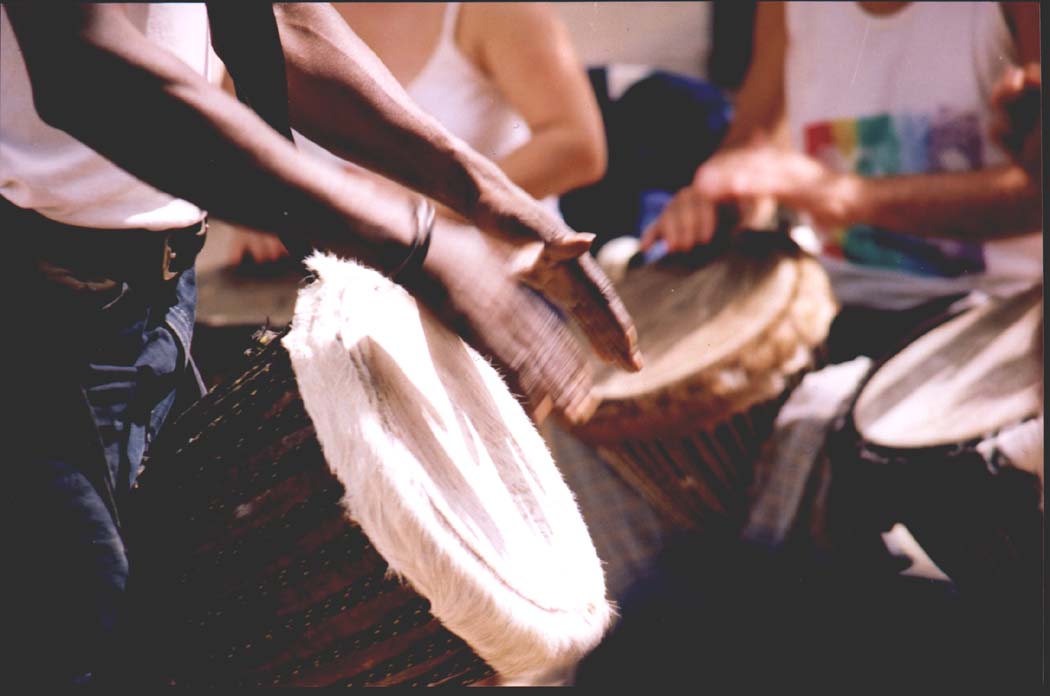By Robert Lawrence Friedman
When Ginger Graziano lost her 19-year-old son to cancer, a tsunami of grief poured over her, leaving her in a seething, inarticulate depression. Without a way to express her anguish, she says, the pain became unbearable. Then one day she heard a drum beat from a nearby meadow and felt an immediate, visceral response. Although she had never played any kind of drum before, she went right out and bought one’a djembe, an African drum. Some instinct told her that whatever she needed to heal, she could access by drumming.
The first time she sat down and began to beat on the drum, she felt the naked ferocity of anger pouring through her hands. Over time, however, anger gave way to sadness, sadness to acceptance, and acceptance’eventually’to joy. The drum, and a monthly drum circle, provided Graziano a way to express the inexpressible and become whole again.
Unfortunately conventional medicine often dismisses music making’once one of the central healing strategies of antiquity’as mere entertainment. Recent studies, however, confirm the benefits of drumming’s restorative powers.
The longevity beat
In 2001, Barry Bittman, MD, of the Mind-Body Institute in Massachusetts, completed the first clinical research study of drumming. The rationale? To show that if an individual drummed with a group, his or her stress-related hormones would diminish. In the study, the participants had their blood drawn before and after each drumming session in order to determine any physiological changes.
On a cellular level, the study demonstrated significant boosts in immune function. After experiencing a drumming protocol called composite drumming’a series of dynamic activities using drums and other rhythm instruments’the participants’ natural killer cell and lymphokine cell activity increased. The promising conclusion: Involvement in varied drumming activities can be an innovative way to lower stress and improve overall health.
One year later, Bittman completed a second clinical research study with 125 long-term healthcare workers. (In both studies the focus was never on creating good-sounding music, but on self-expression and “musical outcomes.”) The participants included accounting, clerical, and cleaning staff as well as RNs.
Besides the composite drumming protocol, Bittman introduced two additional elements. Using the drums only, participants were asked to express their response to two different questions each week. A typical question: “What are you bringing to work today from your personal life and how does it sound? Each session ended with improvisational drumming or talking about any physical or emotional changes the individuals experienced. At the completion of the study, the results showed an appreciable reduction in employee burnout and a marked boost in participants’ moods, which further translated to cost-savings in employee turnover and sick days.
Not only can drumming help you live longer and process your emotions, but it can also help keep your brain healthy. Rhythm is processed globally throughout the brain, says registered music therapist Barry Bernstein, MT-BC. This explains, he says, why even late-stage Alzheimer’s patients can concentrate on playing the drums for 30 minutes (an eternity in the Alzheimer’s mindscape). This natural affinity for drumbeats stems from the way the brain processes the drumming rhythm’primarily in the cerebellum or lower portions of the brain, which remain active even while Alzheimer’s disease disrupts the cerebral cortex or higher functions of the brain.
Worth a thousand words
For people suffering from emotional blocks such as anger or sadness, hitting a drum can provide a way to release those feelings without having to find the right words to express them. Drumming seems to be a direct gateway that connects an individual to her emotional self. For some, hitting a drum almost imperceptibly removes internalized blocks. With inhibitions out of the way, one’s inherent happiness can circulate unimpeded as invigorating rhythms. Just like the bereft Graziano, other individuals who have participated in drumming exercises say that hitting the drum allowed them to move from despair to faith and from devastation to equilibrium.
Curious to explore drum-facilitated catharsis, but don’t know where to start? Get your hands, literally, on a drum, and then try the exercise on page 78 for rhythmic and emotional relief.
Drum Your Way Through Negativity
This drumming technique works quite well with emotions ranging from frustration to anger. However, if you feel overwhelmed by your feelings, please enlist the help of a qualified therapist or music therapist to help you get the most benefit from this exercise. Using a drum with a beater, such as a Buffalo Drum’a single headed drum played with a soft-tipped stick (beater or mallet)’makes the most sense since hitting the drum with your bare hands when letting go of anger can hurt!
1. Be in an environment where you won’t feel restricted in expressing your emotions. Keep your eyes open throughout the exercise.
2. With the beater in your dominant hand and the hand drum in the other, begin to focus on the emotion(s) you are feeling.
3. Hit the drum gently at first, making sure to keep your breathing even and relaxed.
4. Give yourself permission to hit the drum harder and harder, focusing on your feelings, not your thoughts. If you feel like yelling or screaming as you drum, do that.
5. You may notice that your emotions shift as you continue with this exercise, moving from anger to sadness, or even to joy. Allow yourself to feel each emotion that arises.
6.Trust yourself to know when the time comes to wind down. Once complete, you may want to process what the experience was like for you with your therapist or music therapist.






